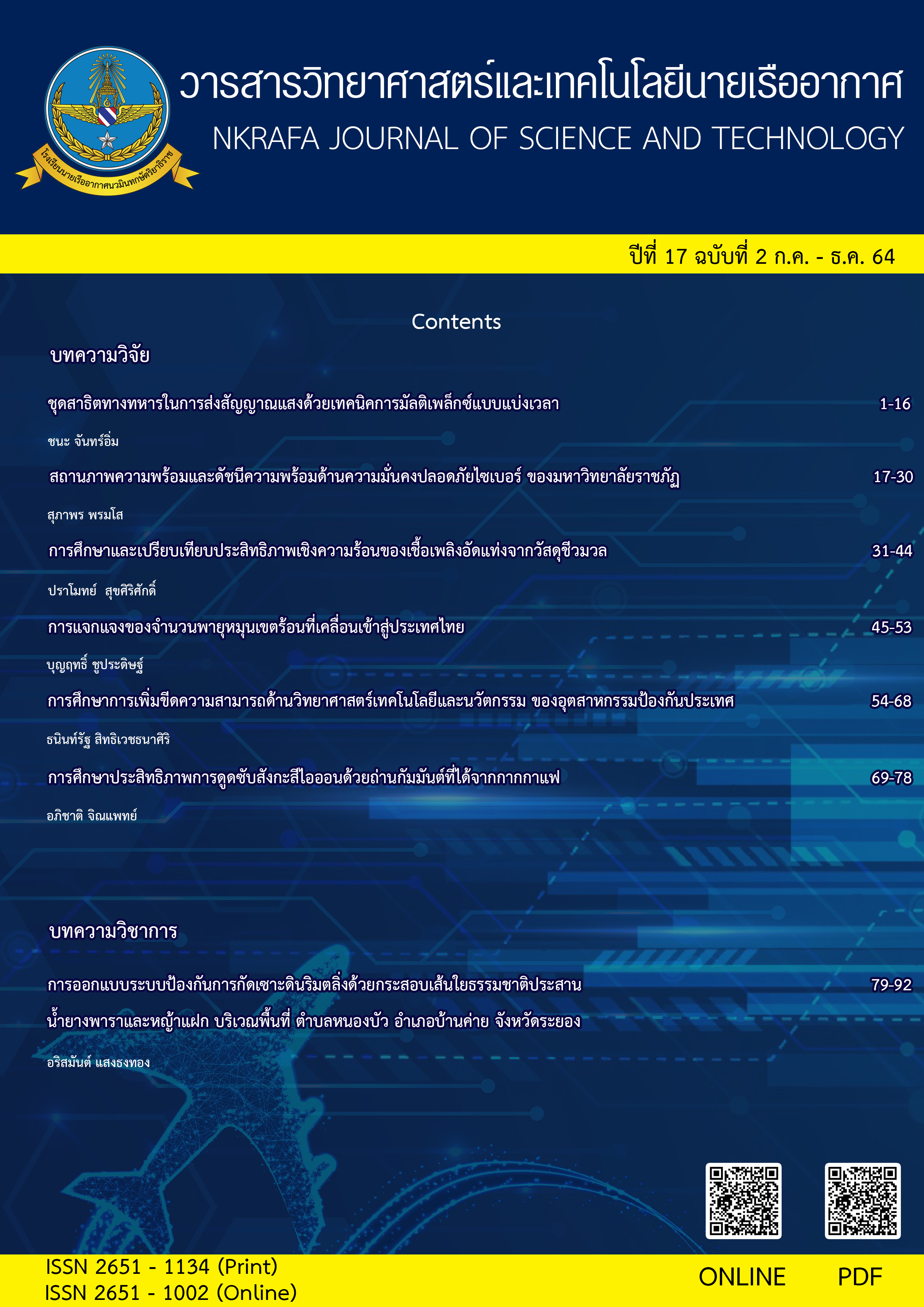การศึกษาประสิทธิภาพการดูดซับสังกะสีไอออนด้วยถ่านกัมมันต์ที่ได้จากกากกาแฟ
Main Article Content
บทคัดย่อ
งานวิจัยนี้ ศึกษาประสิทธิภาพการดูดซับสังกะสีไอออน (Zn2+) ด้วยถ่านกัมมันต์ที่ได้จากกากกาแฟ โดยการกระตุ้นทางเคมีและการคาร์บอไนซ์ ถ่านกัมมันต์ที่ได้ทำการตรวจสอบสมบัติทางกายภาพในรูปของค่าการดูดซับไอโอดีน ตามมาตรฐาน ASTM D4607 - 94(2011) พื้นที่ผิวจำเพาะ BET ปริมาตรรูพรุนรวม และขนาดรูพรุนเฉลี่ย ตามมาตรฐาน ASTM D6556 - 10 สภาวะที่เหมาะในกระบวนการสังเคราะห์ถ่านกัมมันต์ที่ได้จากกากกาแฟ คือโดยใช้การกระตุ้นด้วย H3PO4 และเผาที่อุณหภูมิ 450 OC เป็นเวลา 3 ชั่วโมง ถ่านกัมมันต์ที่ได้มีสมบัติมีค่าการดูดซับไอโอดีนสูงที่สุดเท่ากับ 587 mg/g พื้นที่ผิวจำเพาะ BET เท่ากับ 1,201 m2/g ปริมาตรรูพรุนรวมเท่ากับ 0.799 cm3/g และขนาดรูพรุนเฉลี่ย 2.71 nm นอกจากนี้ งานวิจัยนี้ยังได้ศึกษาสภาวะที่เหมาะสมในการดูดซับสังกะสีไอออน (Zn2+) พบว่า ความเข้มข้นของสังกะสีไอออน เท่ากับ 144 ppm และระยะเวลาการดูดซับที่ 24 ชั่วโมง ถ่านกัมมันต์ที่สังเคราะห์ได้สามารถดูดซับสังกะสีไอออน ได้เท่ากับ 3.771 mg/g
Article Details

อนุญาตภายใต้เงื่อนไข Creative Commons Attribution-NonCommercial-NoDerivatives 4.0 International License.
- เนื้อหาและข้อมูลในบทความที่ตีพิมพ์ในวารสารวิทยาศาสตร์และเทคโนโลยีนายเรืออากาศ ถือเป็นข้อคิดเห็นและความรับผิดชอบของผู้เขียนบทความโดยตรง กองบรรณาธิการวารสาร ไม่จำเป็นต้องเห็นด้วย หรือร่วมรับผิดชอบใด ๆ
- บทความ ข้อมูล เนื้อหา รูปภาพ ฯลฯ ที่ได้รับการตีพิมพ์ในวารสารวิทยาศาสตร์และเทคโนโลยีนายเรืออากาศถือเป็นลิขสิทธิ์ของวารสารวิทยาศาสตร์และเทคโนโลยีนายเรืออากาศ หากบุคคลหรือหน่วยงานใดต้องการนำทั้งหมดหรือส่วนหนึ่งส่วนใดไปเผยแพร่ หรือเพื่อกระทำการใด ๆ จะต้องได้รับอนุญาตเป็นลายลักอักษรณ์จากวารสารวิทยาศาสตร์และเทคโนโลยีนายเรืออากาศ ก่อนเท่านั้น
เอกสารอ้างอิง
สถาบันวิจัยพืชสวน กรมวิชาการเกษตร. (2561). ยุทธศาสตร์กาแฟ ปี 2560 – 2564. กรุงเทพมหานคร: สถาบันวิจัยพืชสวน.
วริทธิ์นันท์ ชุมประเสริฐ และคณะ. (2563). กาแฟคุณภาพ...ทางออกของเกษตรกรไทย. แบ่งปันความรู้...สู่ภูมิภาค. (2): 1-3.
ปัทมา หาญนอก, ภารดี ธรรมาภิชัย และกฤษฎา สารหงส์. (2563) การตรวจสอบเบื้องต้นลักษณะทางกายภาพของข้าวโพดปลูกในดินที่ประกอบด้วยกากกาแฟ. วารสารผลิตกรรมการเกษตร. 2(3): 63-72.
อนุชา เสลานอก, ธีระยุทธ์ เพ็งชัย และมาริญา ทรงปัญญา. (2561). การศึกษาแนวทางการนำกากกาแฟมาใช้เป็นวัตถุดิบในการออกแบบผลิตภัณฑ์ชุดสปา. วารสารวิจัยการออกแบบแห่งเอเชีย. 1(1): 45-53.
นฤภัทร ตั้งมั่นคงวรกูล และพัชรี ปรีดาสุริยะชัย. (2558). การศึกษากากกาแฟและกากชามาใช้ประโยชน์ในรูปเชื้อเพลิงอัดแท่ง. วารสารมหาวิทยาลัยศรีนครินทรวิโรฒ (สาขาวิทยาศาสตร์และเทคโนโลยี). 7(13): 15-26.
ธัญพิสิษฐ์ พวงจิก. (2558). ถ่านกัมกัมม์จากไม้ไผ่: ตลาดยังมีความต้องการสูง?. วารสารวิทยาศาสตร์และเทคโนโลยี. 23(6): 945-954.
วิรังรอง แสงอรุณเลิศ. (2558). การดูดซับสีย้อมผ้าด้วยถ่านกัมมันต์ที่ผลิตจากเปลือกไข่และเปลือกหอยแครงโดยวิธีกระตุ้นทางเคมี. วารสารวิชาการวิทยาศาสตร์และเทคโนโลยี มหาวิทยาลัยราชภัฏนครสวรรค์. 7(7): 97-110.
ธีรดิตถ์ โพธิตันติมงคล. (2560). ถ่านกัมมันต์จากวัสดุเหลือใช้ทางการเกษตรโดยการกระตุ้นทางเคมีเพื่อประยุกต์ใช้กำจัดสารมลพิษในน้ำ. วารสารหน่วยวิจัยวิทยาศาสตร์ เทคโนโลยี และสิ่งแวดล้อมเพื่อการเรียนรู้. 8(1): 196-214.
พัชรี คำธิตา และธนกรกาญจน์ ลิ้มเลิศเจริญวนิช. (2562). การบำบัดน้ำมันหล่อลื่นที่ใช้แล้วด้วยกรดอะซิติกพร้อมกับการดูดซับโลหะหนักด้วยถ่านกัมมันต์จากผักตบชวา. วารสารวิทยาศาสตร์และเทคโนโลยี. 27(1): 56-67.
สำนักงานนโยบายและแผนทรัพยากรธรรมชาติและสิ่งแวดล้อม. (2564). รายงานสถานการณ์คุณภาพสิ่งแวดล้อม พ.ศ.2563. พิมพ์ครั้งที่ 1. กรุงเทพมหานคร: หนึ่งเก้าสองเก้า.
ฉวีวรรณ เพ็งพิทักษ์. (2562). ถ่านกัมมันต์. สาระน่ารู้ กรมวิทยาศาสตร์บริการ, กุมภาพันธ์.
ธัญญาลักษณ์ เกียรติธนาสกุล. (2552). การเตรียมถ่านกัมมันต์จากเปลือกไม้ยูคาลิปตัสด้วยวิธีทางกายภาพเพื่อกำจัดตะกั่ว (วิทยานิพนธ์ปริญญามหาบัณฑิต, จุฬาลงกรณ์มหาวิทยาลัย).
อภิปรียา คงสุวรรณ. (2552). การคืนสภาพทองแดงจากสารละลายผสมของทองแดงและตะกั่ว. (วิทยานิพนธ์ปริญญามหาบัณฑิต, จุฬาลงกรณ์มหาวิทยาลัย).
Namane A., et. al. (2005). Determination of the adsorption capacity of activated carbon made from coffee grounds by chemical activation with ZnCl2 and H3PO4. Journal of Hazardous Materials, B119: 189–194.
เกศศิริ เหล่าวชิระสุวรรณ. (2552). การเตรียมและศึกษาคุณสมบัติของถ่านกัมมันต์จากกากกาแฟโดยวิธีการกระตุ้นทางเคมี. วารสารวิชาการ มหาวิทยาลัยหอการค้าไทย. 29(2):116-131.


